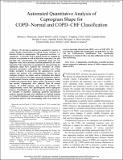Automated Quantitative Analysis of Capnogram Shape for COPD–Normal and COPD–CHF Classification
Author(s)
Mieloszyk, Rebecca J.; Verghese, George, C.; Deitch, Kenneth; Cooney, Brendan; Khalid, Abdullah; Mirre-Gonzalez, Milciades A.; Heldt, Thomas; Krauss, Baruch S.; ... Show more Show less
DownloadIEEE Xplore Full-Text PDF_.pdf (2.446Mb)
OPEN_ACCESS_POLICY
Open Access Policy
Creative Commons Attribution-Noncommercial-Share Alike
Terms of use
Metadata
Show full item recordAbstract
We develop an approach to quantitative analysis of carbon dioxide concentration in exhaled breath, recorded as a function of time by capnography. The generated waveform – or capnogram – is currently used in clinical practice to establish the presence of respiration as well as determine respiratory rate and end-tidal CO2 concentration. The capnogram shape also has diagnostic value, but is presently assessed qualitatively, by visual inspection. Prior approaches to quantitatively characterizing the capnogram shape have explored the correlation of various geometric parameters with pulmonary function tests. These studies attempted to characterize the capnogram in normal subjects and patients with cardiopulmonary disease, but no consistent progress was made, and no translation into clinical practice was achieved. We apply automated quantitative analysis to discriminate between chronic obstructive pulmonary disease (COPD) and congestive heart failure (CHF), and between COPD and normal. Capnograms were collected from 30 normal subjects, 56 COPD patients, and 53 CHF patients. We computationally extract four physiologically based capnogram features. Classification on a hold-out test set was performed by an ensemble of classifiers employing quadratic discriminant analysis, designed through cross-validation on a labeled training set. Using 80 exhalations of each capnogram record in the test set, performance analysis with bootstrapping yields areas under the receiver operating characteristic (ROC) curve of 0.89 (95% CI: 0.72-0.96) for COPD/CHF classification, and 0.98 (95% CI: 0.82- 1.0) for COPD/normal classification. This classification performance is obtained with a run-time sufficiently fast for realtime monitoring.
Date issued
2014-06Department
Institute for Medical Engineering and Science; Massachusetts Institute of Technology. Department of Electrical Engineering and Computer Science; Massachusetts Institute of Technology. Research Laboratory of ElectronicsJournal
IEEE Transactions on Biomedical Engineering
Publisher
Institute of Electrical and Electronics Engineers (IEEE)
Citation
Mieloszyk, Rebecca J., George C. Verghese, Kenneth Deitch, Brendan Cooney, Abdullah Khalid, Milciades A. Mirre-Gonzalez, Thomas Heldt, and Baruch S. Krauss. "Automated Quantitative Analysis of Capnogram Shape for COPD–Normal and COPD–CHF Classification." IEEE Transactions on Biomedical Engineering, (Volume:PP, Issue:99). p.1-9.
Version: Author's final manuscript
ISSN
0018-9294
1558-2531